| British Armed Forces (British Army and British Navy) | |
|---|---|
 Armed Forces Standard | |
| Active | New Modeled Army (1645-1664), British Army and British Navy since 1664 |
| Country |  Commonwealth of England, Scotland and Ireland |
| Allegiance | local county militias (shire militias in Scotland) |
| Branch | British Army British Navy British Air Force |
| Type | Land, sea and air armed forces |
| Role | Territorial defense |
| Colors | Red (Army) and Red and White (Navy) |
| Anniversaries | Defeat of the Spanish Armada (8 August 1588) and Battle of Naseby (14 June 1645) |
| Commanders | |
| Commander-in-Chief | Lord Protector |
| Military coordination | Council of State's Army Council, Admiralty Committee and Air Force Board |
| Army, Navy and Air Force commands | Commander-in-Chief of the Forces and Army Council / Board of Admiralty / Air Force Board |
| Insignia | |
| Standard British Army | 
|
| British Navy White Ensign | 
|
| Roundel British Air Force | 
|
that we were not a mere mercenary army, hired to serve any arbitrary power of a state, but called forth and conjured by the several declarations of parliament to the defence of our own and the people’s just rights and liberties
(From The Representation of the Army, 1647)
The Armed Forces of the Commonwealth are the British Army, Navy and Air Force (the first two Commonwealth Army and Navy until the early 1664), being the former the regularly trained standing army and the Navy the permanent and standing naval warfare force and maritime service of the Commonwealth. Both services integrate the armed forces and ships and have joint commands in England, Scotland and Ireland. The British Air Force is the most recent service.
The British Marines are the amphibious light infantry and a branch of the British Navy.
The Militias are an auxiliary land force of territorial and colonial defense and training. In war they fall under the command of the British Army.
Command Structure[]
The Commander-in-Chief of the Armed Forces is the Lord Protector, to whom members of the forces swear an oath of allegiance. The Army and Navy are managed by a series of committees of Council of State being the main ones of the Army Council and Admiralty Committee. The Commonwealth Parliament yearly establishes its number and personal within the limits of the Constitutional framework or increases it in case of war.
Line of command and administration since 1664.
- Lord Protector: Commander-in-Chief of the Forces
Allegiance to the Commonwealth[]
The New Modelled Army (NMA), the professional army, established, financed and funded and directed by Parliament in the British Civil Wars (1636-1651) during Oliver Cromwell's Protectorship was the main political arbiter and base of the Commonwealth. The Commonwealth Navy, also a die-hard republican, was enlarged in its manpower and fleet.
Their relentless republicanism - the Good Old Cause - and religious radicalism of puritanism and die-hard commitment to religious freedom were the base of Oliver Cromwell's rule (1653–1658). At his death the young Commonwealth was at the crossroads of a restoration of monarchy or the continuation of the republic. Henry Cromwell, a respected general on his own right, on his installation (1658) had the support of Army and the Navy, but it was also obvious to many officers that a dictatorship was not a stable political situation but some kind of institutionalization of republican rule. A series of measures like new Army and Naval Ordinances, the Oath of Allegiance of the Armed Forces took away the power and influence they had but kept republican commitment.
I swear by Almighty God (do solemnly, and truly declare and affirm) that I will be faithful and bear true allegiance to the Commonwealth of England, Scotland and Ireland, and that I will, as in duty bound, honestly and faithfully defend it against all enemies, and will observe and obey all orders of Lord Protector (Lady Protectress), and of the (admirals / generals/ air officers) and officers set over me.
(Current Oath of Allegiance of the Armed Forces)
Beginnings British Army[]
The "new modelling" of Parliament's army was first proposed by Sir William Waller in 1644. Parliament's armies were recruited from regional associations but soldiers were often reluctant to campaign away from their local areas, as Waller found to his cost when trying to control his mutinous London regiments. Waller proposed the formation of a national army with no regional affiliations and the idea was taken up by Oliver Cromwell in a speech to the House of Commons in December 1644. The Self-denying Ordinance was hurried through the Commons to sweep away the existing military high command and the New Model Army Ordinance was passed on 19 February 1645.
The British Army came into being with the unification of England, Scotland and Ireland in the Commonwealth in 1664. The Army has traditionally relied on volunteer recruits. The Army is organized in Foot, Horse, Dragoon and Artillery regiments. The local county militias (shire militias in Scotland) are trained by the British Army and come under its command in state emergencies.
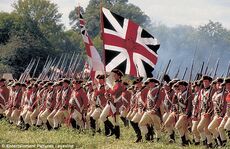
British Army drill (foot)
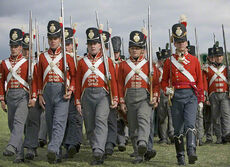
Standard uniforms of the British Army during the European Revolutionary Wars
The Army Council is the military high command and in charge of the army in the field in times of war along the Protector. The Army Council as part of the State Council besides its military members it also has civil commissioners.
There are other bodies that provide support to the army. These are the Board of Ordnance and Commissariat. The former acts as custodian of the lands, depots and forts required for the defence of the realm and its overseas possessions, and as the supplier of munitions and equipment to both the Army and the Navy. The Commissariat is in charge of the provision of supplies, both food and forage, for the troops.
[]
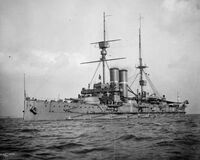
The Commonwealth class BNS[1] Britannia
The development of the British Navy really took off under the leadership of Oliver Cromwell, after the end of the civil wars in 1649. At this time the British Isles began to rely on its navy as the source of their wealth and defense. Between 1646 and 1659 the navy grew by an outstanding 217 vessels: 111 captured and 106 were built.
The command of the British Navy is through the Admiralty Committee. The commission, building and maintenance of ships, supplies and maintenance of navy ports are carried out by the Navy Commission.
British Air Force[]
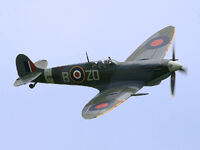
The Spitfire, the main fighter aircraft of the BAF.
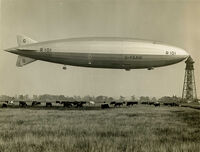
The R-101 preparing for its last flight before being decommissioned.
The British Air Force (BAF) was formed from the Air Corps of the British Army and the Naval Corps of Airships. Along the Navy it has provided a key role in the defense of the British Isles. The operational air fleet consists of airplanes and helicopters. It formerly operated airships (blimps) that were made obsolete by modernization. The RAF also provides airborne intelligence and reconnaissance.
British Marines[]
The British Marines, originally the Marine Forces, are the amphibious light infantry and a branch of the British Navy. The Marines were created during the War of the Spanish Succession and excelled in the landing of Reykjavik on the Battle of Iceland and the campaign of the Danish Straits. These actions were notable in being the first ones to use steam powered landing vessels.
Militias and Regimental Corps[]
The local county militias (shire militias in Scotland) also come under its administration of the British Army by having a common training and command regulations and rules. The militias also provide the main recruitment system of the Army. The militias are the main land force of the overseas territories of the Commonwealth. Although a volunteer force and unable to serve overseas conscription to the British Army is financially rewarded.
The Regimental Corps are the American equivalent of the militias but with a five year conscription.
- New England Militia Regiments (1757), replaced the Dominion Militia of New England (1676)
- Virginia Provincial Regiment (1757) and its Navy (1762)
- Maryland Provincial Regiment and the Naval Militia (1757)
- Nova Scotia Regiment and the Nova Scotia Fleet
- West India Regiments
- West African Frontier Force, auxiliary force of the African Command of the British Army
Regional and Company Armed Forces and Gendarmerie[]
North America - Similar profesional recruit armed forces, but with a separate command status are:
Company Army and Navy of Borealia - commander-in-chief and officers named by the Hudson Bay Company (HBC)
British India - commander-in-chief and officers named by the East India Company until 1804. From 1804 under the command and appoint of officers by the First Commissioner and the secretaries of Army and Air Forces and Navy Affairs.
a) Presidencies armies (Bengal, Bombay and Madras), amalgamated into the British Indian Army (BIA) and the Native Army Auxiliaries (NAA) - commander-in-chief and officers named by the East India Company until 1804.
b) British Indian Navy (BIN), from the Bombay and Bengal Navies - commander-in-chief and officers named by the East India Company until 1804.
c) Air Forces of British India (AFBI)
Africa
West Coast Regiments - commander-in-chief and officers named by the Company of Adventurers Trading to Africa until split in the West African Frontier Force, and the West African Constabulary
Gendarmerie organised police and law enforcement corps
- British Gendarmerie
- Borealia Mounted Police
- North-West Mounted Guard (NWMG)
- West African Constabulary
[]
Officer ranks of the British Army and Navy
| British Army | British Navy | Marine Forces / British Marines | British Air Force (BAF) | Militias | British Gendarmerie and similar corps | |
|---|---|---|---|---|---|---|
| Captain-General | ||||||
| OF-10 | Field Marshall | Admiral of the Fleet | Marshal of the Air Force | Deputy Adjutant-General | General-Commissioner | |
| OF-9 | General (old: Captain-general) | Admiral / General at sea | General | Air Chief Marshal | Adjutant General | General |
| OF-8 | Lieutenant-General | Vice admiral | Lieutenant-General | Air Marshal | Lieutenant-General | Lieutenant-General |
| OF-7 | Major-General (old Sergeant-major-general) | Rear admiral | Major-General | Air Vice-Marshal | Major-General | Major-General |
| OF-6 | Brigadier | Commodore | Brigadier | Air Commodore | Brigadier | Brigadier-General |
| OF-5 | Colonel | Captain | Colonel | Group Captain | Colonel | Colonel |
| OF-4 | Lieutenant colonel | Commander | Lieutenant colonel | Wing Commander | Lieutenant colonel | Lieutenant colonel |
| OF-3 | Major | Lieutenant Commander | Major | Squadron Leader | Major | Major |
| OF-2 | Captain | Lieutenant | Captain | Flight Lieutenant | Captain | Captain |
| OF-1 | Lieutenant / Second-lieutenant or Ensign
(Cavalry equivalent: Cornet) / Captain-lieutenant: (Lieutenant of the First Company) |
Sub-lieutenant / Midshipman | Lieutenant / Second-lieutenant | Flying Officer / Pilot Officer | Lieutenant | Lieutenant |
Other ranks of the British Army and Navy
| British Army | British Navy | Marine Forces / British Marines | British Air Force (BAF) | Militia | British Gendarmerie and similar corps | |
|---|---|---|---|---|---|---|
| OR-9 | Warrant Officer Class 1 | Warrant Officer Class 1 | Warrant Officer Class 1 | Warrant Officer | Warrant Officer Class 1 | Chief Warrant Officer |
| OR-8 | Warrant Officer Class 2 | Warrant Officer Class 2 | Warrant Officer Class 2 | Master warrant officer | ||
| OR-7 | Staff/Colour Sergeant | Chief Petty Officer | Colour Sergeant | Flight Sergeant / Chief Technician | Staff Sergeant | Warrant officer |
| OR-6 | Sergeant | Petty Officer | Sergeant | Sergeant | Sergeant | Sergeant |
| OR-5 | Master corporal | |||||
| OR-4 | Corporal | Leading Rate | Corporal | Corporal | Corporal | Corporal |
| OR-3 | Lance Corporal | Lance Corporal BAF Regiment | Lance Corporal | Senior constable | ||
| OF-2 | Private | Able Seaman | Marine | Senior Aircraftman (Technician) / Senior Aircraftman / Leading Aircraftman | Private | Constable |
| OF-1 | Aircraftman | Cadet |
| |||||||||||||||||||||||
- ↑ British Navy Ship
